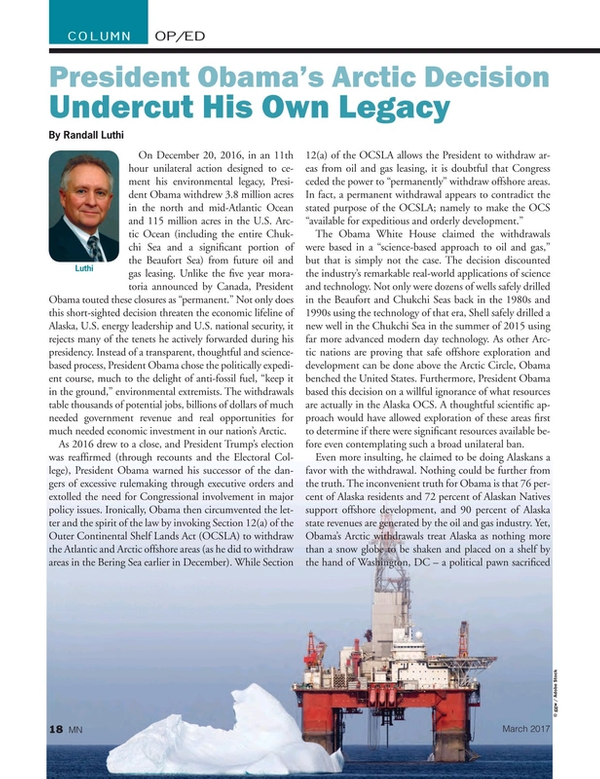On December 20, 2016, in an 11th hour unilateral action designed to cement his environmental legacy, President Obama withdrew 3.8 million acres in the north and mid-Atlantic Ocean and 115 million acres in the U.S. Arctic Ocean (including the entire Chukchi Sea and a significant portion of the Beaufort Sea) from future oil and gas leasing. Unlike the five year moratoria announced by Canada, President Obama touted these closures as “permanent.” Not only does this short-sighted decision threaten the economic lifeline of Alaska, U.S. energy leadership and U.S. national security, it rejects many of the tenets he actively forwarded during his presidency. Instead of a transparent, thoughtful and science-based process, President Obama chose the politically expedient course, much to the delight of anti-fossil fuel, “keep it in the ground,” environmental extremists. The withdrawals table thousands of potential jobs, billions of dollars of much needed government revenue and real opportunities for much needed economic investment in our nation’s Arctic.
As 2016 drew to a close, and President Trump’s election was reaffirmed (through recounts and the Electoral College), President Obama warned his successor of the dangers of excessive rulemaking through executive orders and extolled the need for Congressional involvement in major policy issues. Ironically, Obama then circumvented the letter and the spirit of the law by invoking Section 12(a) of the Outer Continental Shelf Lands Act (OCSLA) to withdraw the Atlantic and Arctic offshore areas (as he did to withdraw areas in the Bering Sea earlier in December). While Section 12(a) of the OCSLA allows the President to withdraw areas from oil and gas leasing, it is doubtful that Congress ceded the power to “permanently” withdraw offshore areas. In fact, a permanent withdrawal appears to contradict the stated purpose of the OCSLA; namely to make the OCS “available for expeditious and orderly development.”
The Obama White House claimed the withdrawals were based in a “science-based approach to oil and gas,” but that is simply not the case. The decision discounted the industry’s remarkable real-world applications of science and technology. Not only were dozens of wells safely drilled in the Beaufort and Chukchi Seas back in the 1980s and 1990s using the technology of that era, Shell safely drilled a new well in the Chukchi Sea in the summer of 2015 using far more advanced modern day technology. As other Arctic nations are proving that safe offshore exploration and development can be done above the Arctic Circle, Obama benched the United States. Furthermore, President Obama based this decision on a willful ignorance of what resources are actually in the Alaska OCS. A thoughtful scientific approach would have allowed exploration of these areas first to determine if there were significant resources available before even contemplating such a broad unilateral ban.
Even more insulting, he claimed to be doing Alaskans a favor with the withdrawal. Nothing could be further from the truth. The inconvenient truth for Obama is that 76 percent of Alaska residents and 72 percent of Alaskan Natives support offshore development, and 90 percent of Alaska state revenues are generated by the oil and gas industry. Yet, Obama’s Arctic withdrawals treat Alaska as nothing more than a snow globe to be shaken and placed on a shelf by the hand of Washington, DC – a political pawn sacrificed to appease environmentalists and anti-fossil fuel activists thousands of miles away from daily life in Alaska.
While the U.S. sits on the sidelines of the Arctic, energy demand will continue to increase in the coming decades, both here in the U.S. and around the world. Some estimates expect the global middle class to double within the next 15 years. This means more people will want to cool their homes, fuel their cars, charge their phones and power modern appliances. By 2040, global energy demand could surge by 41 percent. With an estimated 26 billion barrels of oil and 131 trillion cubic feet of natural gas offshore Alaska, the resources in the Beaufort and Chukchi Seas could fulfill a vital role in the world’s energy future.
Fortunately, few federal policies are permanent, and regarding executive actions, history has shown that one president can undo another president’s actions. In 2008, President George W. Bush used a simple presidential memorandum to remove previous Section 12(a) withdrawals. In addition, Congress has the authority to pass legislation explicitly allowing the President to reverse or revise Section 12(a) withdrawals. Either way, it will take time, energy and dedication to undo Obama’s harmful withdrawals, especially as the extreme environmental community has vowed to fight any reversal of President Obama’s unilateral decision at every step.
The same goes for undoing the myriad of harmful Obama administration regulatory actions imposed on the offshore oil and gas industry; there is no quick fix. However, even faced with these challenges, the outlook for our industry in 2017 is much brighter than it was in 2016. Both the Trump administration and the new Congress appear to understand the benefits of an all-of-the-above approach to energy policy, and President Trump himself has repeatedly spoken in support of offshore energy. NOIA looks forward to working with the new administration and with Congress to develop a truly balanced energy policy that creates a path forward for offshore growth and development and puts all our energy options back on the table.
The Author
Randall Luthi is President of the National Ocean Industries Association (NOIA).
(As published in the March 2017 edition of
Marine News)



